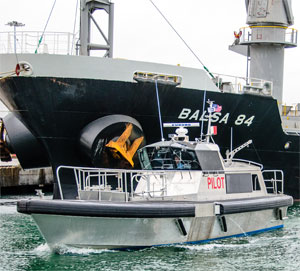Capt. Mike Rigby, the senior boat captain and director of engineering for the Canaveral Pilots Association at Port Canaveral, Fla., worked with naval architect Bill Preston at Marine Design in Gulf Breeze, Fla., for a year to gain the pilots’ approval for the design of their new pilot boat, Timucua.
The 45-foot aluminum craft, named for a local Native American tribe, was built at Metal Shark’s new facility at Franklin, La. Rigby and the Canaveral Pilots specified Preston’s single bow-mounted engine design, a configuration that places the weight forward. When combined with an extremely sharp forward entry, the vessel cuts through seas rather than roller-coasting.
“We have nearly five miles of exposure to the South Atlantic and it can get very nasty at times,” said Rigby. “The design makes for a comfortable ride but doesn’t compromise the performance of the boat. She easily cruises at 18 knots in 3- to 5-foot seas, combining single-engine economy with a comfortable big-boat ride.”
The Canaveral Pilots prefer a single-screw pilot boat because, when they work alongside submarines, there is less chance of doing damage. “With two screws you can bump,” said Rigby.
Timucua is powered by a John Deere 6135 SFM 13.5-liter, 650-hp, six-cylinder, in-line main engine with a Twin Disc 5135 gear at a 2:1 ratio. The propeller is a 32-inch-diameter-by-38-inch-pitch, five-blade Michigan Wheel supplied by Hale Propeller.
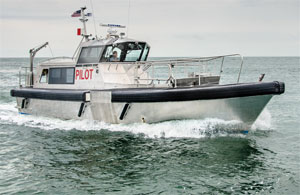 |
|
The 45-foot aluminum boat passes the bow of the 348-foot general cargo ship Balsa 84. |
The 3-inch Aquamet shaft is enclosed in an Evolution Marine Shaft System that totally immerses the shaft in an oil bath within a 4-inch aluminum housing. “The shaft is 17 feet from gear to propeller and has very little loss in horsepower,” said Rigby. “It’s a highly efficient system. There are no cutlass bearings and we have no noticeable vibration issues.”
The mechanically raised engine hatch, with a configuration of handrails attached, is forward of the pilot boarding area, fronting the pilothouse. “The hatch is unique to Bill Preston,” said Rigby. “Handrails are a very important feature on pilot boats.” There is a rescue davit, and the 3-foot rescue platform on the stern makes for a LOA of 48 feet.
Metal Shark added wraparound glass in the pilothouse that substantially reduces blind spots. This safety feature is useful when transferring a pilot, especially during inclement weather and at night.
Port Canaveral, sandwiched by larger ports north and south, is a surprisingly busy port. Cruise ships make up 85 percent of the port visits. The remainder is made up of tankers, car carriers, reefer ships, salt ships, bulk cargo and naval ships. The pilots’ association consists of seven pilots, an apprentice pilot, four permanent boat operators, two part-time boat operators and a business director.
Timucua replaced Pilot Boat No. 1, built in 1990 at Midship Marine in Harvey, La. Pilot Boat No. 2, an approximate sister vessel to Timucua, also designed by Bill Preston, was built by Winninghoff Boats of Rowley, Mass., in 1998. “We lengthened Timucua by five feet, widened her one foot and raised the pilothouse,” said Rigby. “The boat performs far beyond our expectations.”
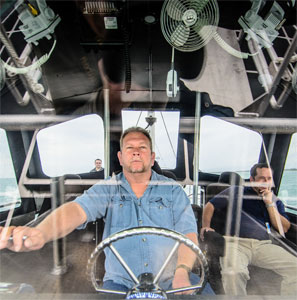 |
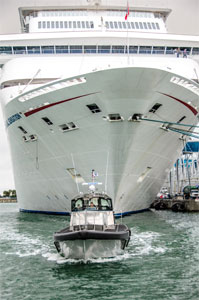 |
|
|
Capt. Mike Rigby, the pilots’ senior boat operator and director of engineering, transports managing pilot Capt. Benjamin Borgie. |
|
Timucua passes by the cruise ship Carnival Celebration in the harbor. Cruise ships represent 85 percent of the business at Port Canaveral. |
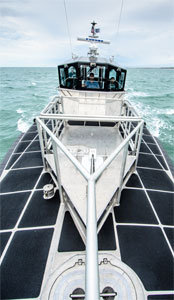 |
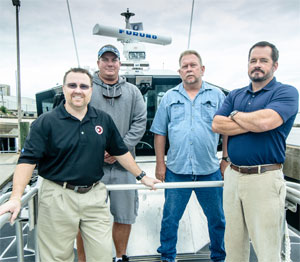 |
|
|
Timucua’s engine room hatch lifts electronically for access and has handrails. |
|
Meeting up on the boat are pilot association business director Capt. Doug Mutter, boat operator Capt. Lee Meyers, Rigby and Borgie. |
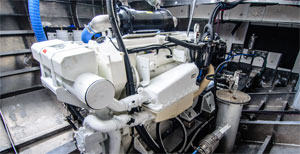 |
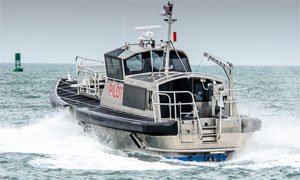 |
|
|
The pilot boat’s 650-hp John Deere 6135 main engine. |
|
Timucua speeds full-throttle out toward the sea buoy. Wraparound glass in the pilothouse aids visibility and makes pilot transfers safer. |

